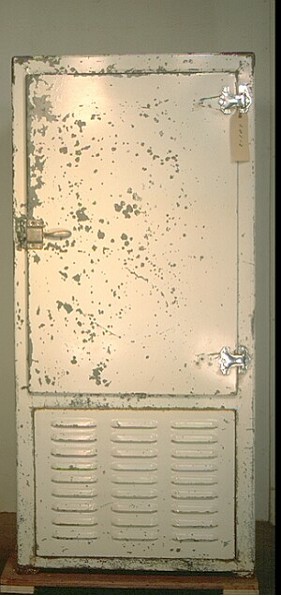Unitary Refrig and A/C Equipment and Systems – Household Cabinet Refrigerators
This condensing unit, noisy and dirty, often with the smell of sulphur dioxide was designed for “remote” mounting in the basement of the home, to be reconnected to the refrigerator cabinet with copper tubing
Technical Significance:
Unitary Refrigeration Equipment: The idea of a unitary piece of refrigeration or air conditioning equipment was a significant one in its own right, one that had to wait its time. The scientists, engineers and inventors in the early years of the 20th century were intrigued and obsessed with the power of the technology and of its possible market potential. What they saw was the newly discovered principles of physics and heat engines – following, for example, the early works of Carnot, Faraday, Kelvin, and the later work of Perkins, Larsen and Carrier, to name a few. They understood the promise of the technology for the public good, not to say its consumer sales potential. Early engineering work advanced on a multiple fronts with development of compressors, heat exchangers, valves and piping variously strung together in configurations that would be found to work, but only after much experimentation.
The arrival of unitary equipment, all those parts organised into a single whole, a single unit of construction, a “black box”, that could be offered to the consumer market was a significant technological and cultural event. Technologically the refrigerator would need to be seen to be safe, reliable, maintainable and useful. As well, in order to attract the development capital needed, it must be seen as potentially saleable and affordable, contributing to life’s needs and desires. Its socio- cultural and economic significance was marked, for it would change much. As Canadians we would quickly come enjoy potentially healthier lives, expect new levels of comfort and convenience, with a broader, safer, more diverse and enjoyable diet.
Canadians would quickly come to think of their day differently, for the day would be defined and punctuated in different ways than ever before, as a result of the introduction of modern, electric, household appliances, of which refrigerators, freezers and room air conditioners would be a central part, by the mid 20th century
J. M Larsen produced a manually operated household refrigerator of sorts in 1913, but it was not until 1918 that the Kelvinator Company marketed the first automatic, unitary refrigerator for the home. In that year, it is reported to have sold sixty-seven machines. (See Note 1) The historic artifacts in Group 1.00, Unitary Equipment, including significant samplings the early work of Kelvinator of Canada, provide a rare view of the evolution of unitary refrigeration and air conditioning applications, as they evolved in Canada in the first half of the 20th century.
For those formative years, the artifacts in this Group, 1.00, are typical of the offerings of the Canadian refrigeration and air conditioning industry. They personified the applications found in the homes, farms and commercial premises of the period for, those that could afford life’s new amenities of comfort, convenience and privilege.
This Specimen: This refrigerator stands as a statement of the earliest, embryonic years of refrigerating technology in Canada. Showing the natural effects of ageing and constant use and repair over its 50 year, active, life span. The condensing unit is in original pristine condition with the exception of the 25 cycle motor replaced at the time of frequency conversion in Ontario in 1948, up to which point the machine had been in constant use. The evaporator is likely not original with this machine, but typical of the brine-tank evaporators used in that period. It was a period in which refrigerators were subject to high maintenance, repair over a long life span.
Industrial Significance:
This specimen tells the stories of the early years of the development of the industry in North America, where the commitment of the Industry was to the inherently noisy, mechanically troubled compression refrigeration cycle, with slow speed, often crudely machined “chunking” compressors, open motor drives and fan cooled “whirring” condensers.The marketing of absorption systems, as an alternative, developed by Electrolux in Europe, and licensed to Servel in Evanseville Ind,. would still be several years away.
The early patent and world-wide registration marks Kelvinator as a pioneer in the field, as well as an aggressive global North American marketer. It had high expectations for industry leadership and domination.


